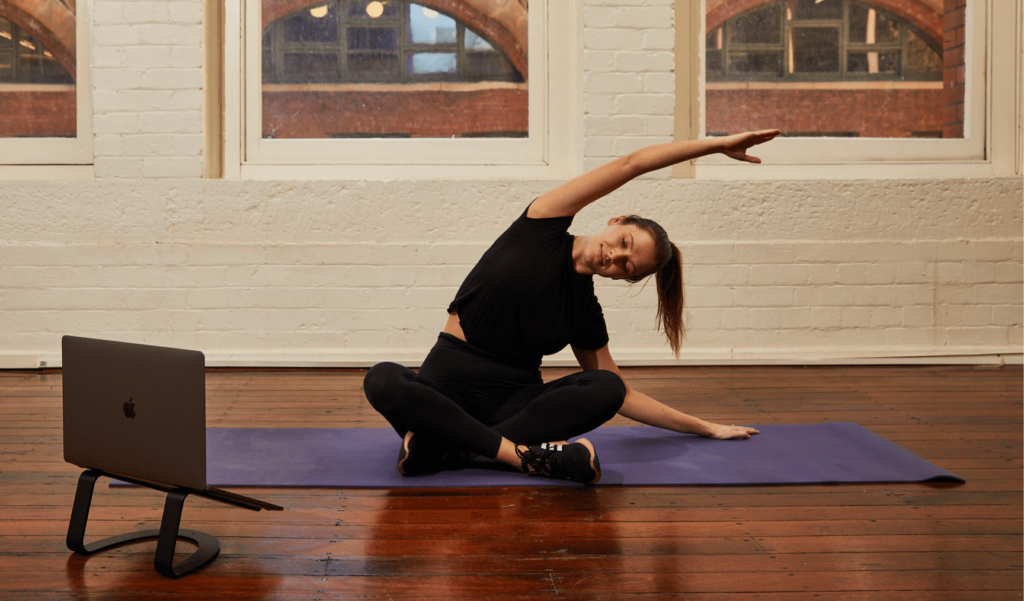8 simple ways to improve workplace ergonomics
It might not sound essential, but this branch of science can make all the difference in how we work.

Contents
Ergonomics! Fun word, un-fun subject.
It might not sound essential, but this branch of science can make all the difference in how we work. Get it right in your workplace, and promote your team’s physical and muscular health. Get it wrong, and you could be causing your employee’s consistent aches and pains.
Get it really wrong, and you could be facing increased workplace compensation claims.
Do we have you sitting straight? Let’s learn more about ergonomics.
What is ergonomics?
Ergonomics is the science of design and behaviours that influence our comfort while working or studying. It’s often associated with well-designed office seating, but it goes far beyond that.
Ergonomics is related to all types of office equipment, the construction of workspaces and the variety of movements that workers make throughout the working day.
Poor ergonomics can cause pain through musculoskeletal disorders (MSD) and injuries. This could be experienced through backache and other muscle pain, carpal tunnel syndrome (a pinched nerve in the wrist which causes hand and arm pain and numbness), arthritis and tendinitis.
How can working from home impact ergonomics?
One day, you decide to try ‘working from bed’. The next day – you’re a millennial with back pain. My friend, you’ve just experienced the consequences of bad ergonomics (welcome to the club!).
People often forget about workplace health and safety when they’re working remotely, but this shouldn’t be the case. Just because homeworkers have comfy places to sit doesn’t mean that’s actually good for their overall comfort.
It’s important to have an ergonomic workstation set up wherever you’re clocking in from.
Under the restrictions of the pandemic, many people threw together workspaces at home – often resorting to kitchen counters, couches and beds in replacement of desks.
As many businesses implement remote and flexible working long-term, helping employees set up ergonomically is an absolute must.
What are the benefits of ergonomics?
The number one benefit of good ergonomics is it prevents injury for your workers. When you reduce aches and injuries, you can trigger a domino effect of positive impacts.
Reduced absenteeism
It’s not an overstatement to say that injuries caused by bad ergonomics can be debilitating. Intense back pain can leave anyone bedbound, and carpal tunnel can make typing a nearly impossible task.
According to SafeWork, musculoskeletal disorders provide a significant ‘economic burden’ to both businesses and employees.
In Australia, 25% of back pain sufferers in the 18-55 age group are taking 10 or more days off per year.
Better engagement
When you’re experiencing physical discomfort, it’s very hard to stay focused and engaged for extended periods of time. Workers suffering from MSD may become frustrated at the lack of proper equipment provided to them by their employer.
Teams understand that, in most cases, MSD is preventable with intervention.
Enhanced productivity
By a similar token, when your employees are in good physical health, they are likely to be more productive. They won’t be distracted by frustrating niggles, or feel the need to be constantly fidgeting to find a better working position.
A culture of safety
As well as having clear positive physical impacts, providing good ergonomic solutions is also good for team morale and business reputation. Creating this culture of workplace health and safety reflects well on your company and sends a clear message to your team that you care about their comfort.
Fewer worker compensation claims
According to SafeWork, MSDs as a result of working account for the majority of compensation costs for Australian workers. As so many MSDs can be prevented by implementing good ergonomic practices, it’s well worth the investment for your team and for your business.
8 simple ways to improve ergonomics in your workspace
1. Invest in better chairs
As it’s the most commonly considered of the ergonomic principles, let’s talk about office chairs.
So, should you be sitting on a swivel chair, stool, exercise ball or one of those fancy posture chairs? While most will opt for the classic office swivel chair, there are a few ergonomic features that differentiate the good from the bad.
According to the UK’s PhysioMed, the chair should meet these specifications;
- The seat should be at least one to three wider on each side of the sitter
- The chair should have lumbar support – it cushions the lower back
- They need to be fully adjustable chairs, with the seat height, back and armrests able to be moved to fit
- Ideally, the seat should tilt slightly forward, but the same effect can also be provided with cushioning
The perfect chair will be comfortable for sitting for extended periods of time, supporting the sitter to keep a straight spine (which is difficult to do naturally for long periods) and prevent slumping. It should allow the sitter to have their feet flat on the floor.

Is your workspace designed for comfort or convenience? Image via Samule Sun.
2. Monitors
Another must in the equipment department are monitors. Laptops are great for convenience and mobility, but the constant looking down can cause neck strain and threaten good posture.
Experts say that when we’re sitting and working, we should be looking directly in front of us. If workers use two computer screens, they should be at a similar height to avoid repetitive motion of the head. A monitor should be about arm’s length away from the worker.
If it’s not possible to provide monitors to your team, advise them to elevate their laptops in some way – whether that’s with a laptop stand or with something like a stack of books. This will require a separate keyboard and mouse to prevent excessive reaching, but these are relatively cheap to acquire.
If using a laptop, workers should also consider increasing the size of the text on their screen to prevent eye strain.
3. Headsets
Does your team use the phone frequently? Even if they’re not in a customer service role, they might be consistently using their mobile or desk phone to communicate or complete their role.
We’re all guilty of holding a phone between our ears and shoulder, feeling the unpleasant muscle strain of the neck. This seemingly innocuous movement can be an injury risk, easily prevented by the use of headsets.
We’re calling it; headsets are the hot accessory of 2022.
4. Consider standing desks
Standing desks are the ergonomic item du jour and for good reason. We know that experts are concerned about sedentary behaviour, and sitting for 7.6 hours five days a week – can be a big contributor to this.
There are some pretty amazing statistics about the positive impacts of standing desks.
As reported in the ABC; “Giving standing desks to 20 per cent of office workers would save $84 million in healthcare costs and 7,492 health-adjusted life years by preventing obesity, type 2 diabetes and cardiovascular disease, according to the first evaluation in Australia.”
It’s worth noting, however, that standing up all of the time is not necessarily recommended as it can transfer strain to the legs and feet. Moving between sitting and standing throughout the day is the optimal situation to reduce strain and awkward postures throughout the body.
5. Encourage movement breaks
If a standing desk is not on the cards, workers should at least take regular movement breaks to give their bodies some relief from sitting.
This is especially true for those working remotely. When in the office, we’re used to walking long distances to the kitchen or bathroom, we’re leaning over to talk to colleagues or dropping by their desks. At home, these opportunities disappear.
Encourage your team to take ‘microbreaks’ throughout the day. Once an hour they should take a stretch or a short walk. This can refresh the body and brain; the BBC suggests microbreaks can improve concentration and improve workers’ perception of their jobs.
6. Provide virtual or in-person yoga
Regular movement is another important part of preventative health, and yoga is a great choice to tackle common MSD symptoms.
According to Johns Hopkins, yoga should be the first point of treatment for chronic back pain. It can also improve flexibility, strength and balance.
Wherever you are, stretch it out.
7. Have walking catch ups
Whatever happened to the humble ‘walk and talk’? We believe that this classic meeting style is incredibly underrated.
When we walk and talk with our colleagues – whether it’s in person or over the phone – we are able to communicate mindfully.
As well as giving our bodies a break from sitting or standing in one spot, we disconnect from our notifications and other distractions and focus more completely on our conversations.
8. Be conscious of environments
Environmental risk factors are an often forgotten part of ergonomics.
When you’re designing or advising on workspaces, it’s also important to solve these common issues;
- How is the workspace lit? Are employees experiencing fatigue under fluorescent lights or straining their eyes in shadowy rooms? How can we create a gentle environment with lighting that feels organic?
- What kind of sounds is your employee hearing? Are they having to battle against constant roadworks or noisy phone calls? Is their space conducive to deep work?
- Is your employee’s workspace a comfortable temperature? Do they have access to fans, air conditioning, heating or insulated spaces?

Wellness for the future of work
In 2022, we’re all about working smarter – not harder. Implementing workplace ergonomics will create a better space for your team to work effectively, no matter where they’re working from.
Ergonomics is an important part of the workplace wellness puzzle. If you’re looking for more ways to help your team do their best work, we have all the information you need.
Or check out these free resources, or learn about Employment Hero’s benefits and engagement tools.
Related Resources
-
 Read more: Product Update: May 2025
Read more: Product Update: May 2025Product Update: May 2025
Follow our May 2025 product update as we share all of the latest and greatest features we’ve released over the…
-
 Read more: Product Update: April 2025
Read more: Product Update: April 2025Product Update: April 2025
Follow our April 2025 product update as we share all of the latest and greatest features we’ve released over the…
-
 Read more: Product Update: March 2025
Read more: Product Update: March 2025Product Update: March 2025
Follow our March 2025 product update as we share all of the latest and greatest features we’ve released over the…









